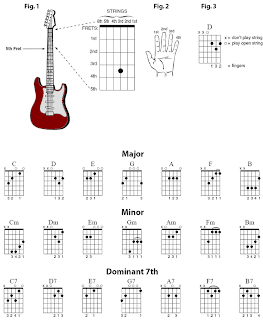In this lesson were going to cover all aspects of playing fast guitar, including speed picked runs, legato phrases and economy picking phrases. Hopefully at the end of this lesson you should have some useful warm up excersises, tips on all picking aspects and lots of excersises to practise with.
This lesson will be split into 5 sections :
1. Warm up excersises
2. Alternative picking
3. Economy picking
4. Legato playing
5. Using these tips musically
Warm Up Excersises
These are a list of simple excersises that are useful for quickly warming up both your hands before playing these excersises. I use these almost everyday and they don't take long but they get your hands all warmed up, getting blood into your hands and getting the muscles pumped into your fingers so after a quick few excersises you feel like youve been playing for hours.
First were going to warm up, were going to give all your fingers are work out. The main focus of warming up fast though is to aim to get your index and pinky fingers warmed up as the rest of the hand will follow. Lets get started:
E|----------------------1h2p1------------------------------------------2h3-
B|------------------1h2-------2p1----------------------------------2h3-----
G|--------------1h2---------------2p1--------------------------2h3---------
D|----------1h2-----------------------2p1------------------2h3-------------
A|------1h2-------------------------------2p1----------2h3-----------------
E|--1h2---------------------------------------2p1--2h3---------------------
E|--3p2-----------------------------------------3h4p3-----------------------
B|------3p2---------------------------------3h4-------4p3-------------------
G|----------3p2-------------------------3h4---------------4p3---------------
D|--------------3p2-----------------3h4-----------------------4p3-----------
A|------------------3p2---------3h4-------------------------------4p3-------
E|----------------------3p2-3h4---------------------------------------4p3---
E|----------------------4h5p4-----------------------------------------5h6---
B|------------------4h5-------5p4---------------------------------5h6-------
G|--------------4h5---------------5p4-------------------------5h6-----------
D|----------4h5-----------------------5p4-----------------5h6---------------
A|------4h5-------------------------------5p4---------5h6-------------------
E|--4h5---------------------------------------5p4-5h6-----------------------
E|--6p5-----------------------------------------6h7p6-----------------------
B|------6p5---------------------------------6h7-------7p6-------------------
G|----------6p5-------------------------6h7---------------7p6---------------
D|--------------6p5-----------------6h7-----------------------7p6-----------
A|------------------6p5---------6h7-------------------------------7p6-------
E|----------------------6p5-6h7---------------------------------------7p6---
This is an excersise which can be replayed with any 2 fingers. To also aide your picking hand you can alternate pick descending ( up, down, up) and sweep (up, up, up) ascending, or mix it up, but don't worry the main aim is to warm up your fretting hand fingers. With this excersise use:1. Index and middle
2. Middle and ring
3. Ring and pinky
Next:
E|----------------------1h3p1-----------------------------------------2h4-
B|------------------1h3------3p1----------------------------------2h4-----
G|--------------1h3--------------3p1--------------------------2h4---------
D|----------1h3----------------------3p1------------------2h4-------------
A|------1h3------------------------------3p1----------2h4-----------------
E|--1h3--------------------------------------3p1--2h4---------------------
E|--4p2-----------------------------------------3h5p3-----------------------
B|------4p2---------------------------------3h5-------5p3-------------------
G|----------4p2-------------------------3h5---------------5p3---------------
D|--------------4p2-----------------3h5-----------------------5p3-----------
A|------------------4p2---------3h5-------------------------------5p3-------
E|----------------------4p2-3h5---------------------------------------5p3---
E|----------------------4h6p4-----------------------------------------5h7---
B|------------------4h6-------6p4---------------------------------5h7-------
G|--------------4h6---------------6p4-------------------------5h7-----------
D|----------4h6-----------------------6p4-----------------5h7---------------
A|------4h6-------------------------------6p4---------5h7-------------------
E|--4h6---------------------------------------6p4-5h7-----------------------
E|--7p5-----------------------------------------6h8p6-----------------------
B|------7p5---------------------------------6h8-------8p6-------------------
G|----------7p5-------------------------6h8---------------8p6---------------
D|--------------7p5-----------------6h8-----------------------8p6-----------
A|------------------7p5---------6h8-------------------------------8p6-------
E|----------------------7p5-6h8---------------------------------------8p6---
Ok this time use:1. Index and ring fingers
2. Middle and pinky fingers
Next:
E|--------------------------------1h2h3p2p1---------------------------------
B|--------------------------1h2h3-----------3p2p1---------------------------
G|--------------------1h2h3-----------------------3p2p1---------------------
D|--------------1h2h3-----------------------------------3p2p1---------------
A|--------1h2h3-----------------------------------------------3p2p1---------
E|--1h2h3----------------------------------------------------------3p2p1----
E|--------------------------------2h3h4p3p2---------------------------------
B|--------------------------2h3h5-----------4p3p2---------------------------
G|--------------------2h3h4-----------------------4p3p2---------------------
D|--------------2h3h4-----------------------------------4p3p2---------------
A|--------2h3h4----------------------------------------------4p3p2----------
E|--2h3h4----------------------------------------------------------4p3p2----
E|--------------------------------3h4h5p4p3---------------------------------
B|--------------------------3h4h5-----------5p4p3---------------------------
G|--------------------3h4h5-----------------------5p4p3---------------------
D|--------------3h4h5-----------------------------------5p4p3---------------
A|--------2h4h5----------------------------------------------5p4p3----------
E|--3h4h5----------------------------------------------------------5p4p3----
E|--------------------------------4h5h6p5p4---------------------------------
B|--------------------------4h5h6-----------6p5p4---------------------------
G|--------------------4h5h6-----------------------6p5p4---------------------
D|--------------4h5h6-----------------------------------6p5p4---------------
A|--------4h5h6----------------------------------------------6p5p4----------
E|--4h5h6----------------------------------------------------------6p5p4----
E|--------------------------------5h6h7p6p5---------------------------------
B|--------------------------5h6h7-----------7p6p5---------------------------
G|--------------------5h6h7-----------------------7p6p5---------------------
D|--------------5h6h7-----------------------------------7p6p5---------------
A|--------5h6h7----------------------------------------------7p6p5----------
E|--5h6h7----------------------------------------------------------7p6p5----
This time use:1. Index ,middle and ring fingers
2. Middle ,ring and pinky fingers
Next:
E|--------------------------------1h2h4p2p1---------------------------------
B|--------------------------1h2h4-----------4p2p1---------------------------
G|--------------------1h2h4-----------------------4p2p1---------------------
D|--------------1h2h4-----------------------------------4p2p1---------------
A|--------1h2h4----------------------------------------------4p2p1----------
E|--1h2h4----------------------------------------------------------4p2p1----
E|--------------------------------2h3h5p3p2---------------------------------
B|--------------------------2h3h5-----------5p3p2---------------------------
G|--------------------2h3h5-----------------------5p3p2---------------------
D|--------------2h3h5-----------------------------------5p3p2---------------
A|--------2h3h5----------------------------------------------5p3p2----------
E|--2h3h5----------------------------------------------------------5p3p2----
E|--------------------------------3h4h6p4p3---------------------------------
B|--------------------------3h4h6-----------6p4p3---------------------------
G|--------------------3h4h6-----------------------6p4p3---------------------
D|--------------3h4h6-----------------------------------6p4p3---------------
A|--------3h4h6----------------------------------------------6p4p3----------
E|--3h4h6----------------------------------------------------------6p4p3----
E|--------------------------------4h5h7p5p4---------------------------------
B|--------------------------4h5h7-----------7p5p4---------------------------
G|--------------------4h5h7-----------------------7p5p4---------------------
D|--------------4h5h7-----------------------------------7p5p4---------------
A|--------4h5h7----------------------------------------------7p5p4----------
E|--4h5h7----------------------------------------------------------7p5p4----
This one uses:1. Index ,middle and pinky
Next:
E|--------------------------------1h3h4p3p1---------------------------------
B|--------------------------1h3h4-----------4p3p1---------------------------
G|--------------------1h3h4-----------------------4p3p1---------------------
D|--------------1h3h4-----------------------------------4p3p1---------------
A|--------1h3h4----------------------------------------------4p3p1----------
E|--1h3h4----------------------------------------------------------4p3p1----
E|--------------------------------2h4h5p4p2---------------------------------
B|--------------------------2h4h5-----------5p4p2---------------------------
G|--------------------2h4h5-----------------------5p4p2---------------------
D|--------------2h4h5-----------------------------------5p4p2---------------
A|--------2h4h5----------------------------------------------5p4p2----------
E|--2h4h5----------------------------------------------------------5p4p2----
E|--------------------------------3h5h6p5p3---------------------------------
B|--------------------------3h5h6-----------6p5p3---------------------------
G|--------------------3h5h6-----------------------6p5p3---------------------
D|--------------3h5h6-----------------------------------6p5p3---------------
A|--------3h5h6----------------------------------------------6p5p3----------
E|--3h5h6----------------------------------------------------------6p5p3----
E|--------------------------------4h6h7p6p4---------------------------------
B|--------------------------4h6h7-----------7p6p4---------------------------
G|--------------------4h6h7-----------------------7p6p4---------------------
D|--------------4h6h7-----------------------------------7p6p4---------------
A|--------4h6h7----------------------------------------------7p6p4----------
E|--4h6h7----------------------------------------------------------7p6p4----
This one uses:1. Index ,ring and pinky fingers.
Last one now:
E|------------------------------------------1h2h3h4p3p2p1----------------
B|----------------------------------1h2h3h4---------------4p3p2p1--------
G|--------------------------1h2h3h4-------------------------------4p3p2p1
D|------------------1h2h3h4----------------------------------------------
A|----------1h2h3h4------------------------------------------------------
E|--1h2h3h4--------------------------------------------------------------
E|-----------------------------------------------------------------------
B|-----------------------------------------------------------------------
G|--4p3p2p1-------------------------------------------------2h3h4h5------
D|----------4p3p2p1---------------------------------2h3h4h5--------------
A|------------------4p3p2p1-----------------2h3h4h5----------------------
E|--------------------------4p3p2p1 2h3h4h5------------------------------
E|----------2h3h4h5p4p3p2------------------------------------------------
B|--2h3h4h5---------------5p4p3p2----------------------------------------
G|--------------------------------5p4p3p2--------------------------------
D|----------------------------------------5p4p3p2------------------------
A|------------------------------------------------5p4p3p2----------------
E|--------------------------------------------------------5p4p3p2-3h4h5h6
E|----------------------------------3h4h5h6p5p4p3------------------------
B|--------------------------3h4h5h6---------------6p5p4p3----------------
G|------------------3h4h5h6-------------------------------6p5p4p3--------
D|----------3h4h5h6-----------------------------------------------6p5p4p3
A|--3h4h5h6--------------------------------------------------------------
E|-----------------------------------------------------------------------
E|----------------------------------------------------------4h5h6h7------
B|--------------------------------------------------4h5h6h7--------------
G|------------------------------------------4h5h6h7----------------------
D|----------------------------------4h5h6h7------------------------------
A|--6p5p4p3-----------------4h5h5h7--------------------------------------
E|----------6p5p4p3-4h5h6h7----------------------------------------------
E|--7p6p5p4--------------------------------------------------------------
B|----------7p6p5p4------------------------------------------------------
G|------------------7p6p5p4----------------------------------------------
D|--------------------------7p6p5p4--------------------------------------
A|----------------------------------7p6p5p4------------------------------
E|------------------------------------------7p6p5p4----------------------
You can pretty much guess what fingers are required here. Now you should be very warmed up, as mentioned earlier some of these hammer-ons and pull offs are quite hard and instead just pick the notes if it's easier.
Alternative Picking
Alternative picking is probably the hardest, used by players like Michael Angelo and Buckethead, this picking style involves picking up and then down repeatly. Even if your changing strings you will have to have a constant up, down, up, down pattern. Alternative picking gives an aggressive, attacking sound when played. Below is a small excersise and we will discuss tips on getting your alternative picking accurate:
E|-----------------------------------------------------------------------
B|-----------------------------------------------------------------------
G|-----------------------------------------------------------------------
D|-----------12-13-12----------------12-13-12----------------12-13-12----
A|--12-14-15----------15-14-12-14-15----------15-14-12-14-15-------------
E|-----------------------------------------------------------------------
D U D U D U D U D U D U D U D U D U D U D U
This is a simple repeat lick excersise, you can play this sort of thing almost anywhere to feel comfortable but we will use this one now for starters. Play this lick constantly using the up, down, up, down motion. So the main issue I'm sure you'l find here is the upstroke on the string change down and the downstroke on the string change up. Practise this likc super slow and build up speed then try these:
E|--8-7-------------------7-8-7-------------------7-8-7------------------
B|------8-7-----------7-8-------8-7-----------7-8-------8-7--------------
G|----------8-7-5-7-8---------------8-7-5-7-8---------------8-7-5--------
D|-----------------------------------------------------------------------
A|-----------------------------------------------------------------------
E|-----------------------------------------------------------------------
D U D U D U D U D U D U D U D U D U D U D U D U D U D U D U D
E|--------------------12-14-15-14-12----------------------------------12-
B|-----------12-14-15----------------15-14-12----------------12-14-15----
G|--12-14-15----------------------------------15-14-12-14-15-------------
D|-----------------------------------------------------------------------
A|-----------------------------------------------------------------------
E|-----------------------------------------------------------------------
D U D U D U D U D U D U D U D U D U D U D U D
E|-----------10----------------10----------------10----------------10----
B|--------11----11----------11----11----------11----11----------11-------
G|-----12----------12----12----------12----12----------12----12----------
D|--11----------------11----------------11----------------11-------------
A|-----------------------------------------------------------------------
E|-----------------------------------------------------------------------
D U D U D U D U D U D U D U D U D U D U D U
That last one may seem tricky, as it's so tempting to sweep/economy pick it, but if you can pull it off it's very useful for training your picking hand. Remeber the key to this picking style is the ability to hit a new string below on an upstroke and a string above on a downstroke.
Economy Picking
Economy picking is a bit like alternative picking, up and down, but when you change string you pick in the direction of the change. So if you going to change to a string down you down stroke and a string up you upstroke. Try this example using economy picking:
E|---------------------------------------------------------------------
B|---------------------------------------------------------------------
G|---------------------------------------------------------------------
D|---------------------------------------------------------------------
A|----------9-12-10-9-10-12------------9-12-10-9-10-12------------9----
E|--9-10-12-----------------12-9-10-12-----------------12 9-10-12------
D U D D U D U D U U D U D D U D U D U U D U D D
Notice how your up and downpicking but on the string change you follow the direction of the strings, it's seems easier than alternative picking and gives are a more smooth, flowing sound, players like Yngwie Malmsteen use this technique a lot and it sounds great with legato playing. Try these out:
E|-----------12-14-15-17-15-14-12-------------12-14-15-17-15-14-12-------
B|--12-14-15----------------------15-12-14-15----------------------15----
G|-----------------------------------------------------------------------
D|-----------------------------------------------------------------------
A|-----------------------------------------------------------------------
E|-----------------------------------------------------------------------
D U D D U D U D U D U D U D D U S U S U D U
E|--------12-10-------------12-10-------------12-10-------------12-10----
B|-----13-------11-------13-------11-------13-------11-------13------11--
G|--14-------------12-14-------------12-14-------------12-14-----------12
D|-----------------------------------------------------------------------
A|-----------------------------------------------------------------------
E|-----------------------------------------------------------------------
D D D U U U D D D U U U D D D U U U D D D U U U
E|--------12-15p12---------12-15p12----------12-15p12----------12-15p12--
B|-----13---------13----13----------13----13----------13----13-----------
G|--12---------------12----------------12----------------12--------------
D|-----------------------------------------------------------------------
A|-----------------------------------------------------------------------
E|-----------------------------------------------------------------------
D D D U U D D D U U D D D U U D D D U
Last one look familiar, it's a sweep picking shape. Economy picking is often refered to as sweep picking. So remeber, alternative pick on one string, pick with the direction of the string change when you change.
Legato Playing
Allthough technically not a picking style, it's is useful in playing fast. Some players don't prefer using legato and accuse it of "cheating". Legato is just as technical and useful in fast playing as any other of the techniques were using. Joe Satriani uses a lot of legato playing in his songs and they're incredibly fast. Legato is latin for "smoothly" and this technique does give an incredible smooth sound when played right. When hammer-ing on, make sure you hammer the string quickly and firmly, a lot of players only really use their middle or ring finger for this, but if you can train your pinky to do it you can reach whole new areas and create interesting licks. For pulling off, one of the main flaws players have is that when they pull off the accidently bend the string that they're pulling off to downwards, this makes the pull off sound out of tune. Make sure the finger your pulling off to holds the string firmly in place and your pulling finger to pluck strick forcefully to get a loud, full pull off.Try these licks out:
E|-----------------------------------------------------------------------
B|-----------------------------------------------------------------------
G|-----------------------------------------------------------------------
D|-------9-7h9------9-7h9------9-7h9------9-7h9------9-7h9------9 7h9----
A|--10p7-------10p7-------10p7-------10p7-------10p7-------10p7----------
E|-----------------------------------------------------------------------
E|--12h13p12h13-------------------------------------12h13p12h13----------
B|--------------12h13p12h13-------------12h13p12h13----------------------
G|--------------------------10h13p10h13----------------------------------
D|-----------------------------------------------------------------------
A|-----------------------------------------------------------------------
E|-----------------------------------------------------------------------
E|----------7p5--------------7p5-------------7p5-------------------------
B|-----------------------------------------------------------------------
G|------5h7-----7p5------5h7-----7p5-----7p5-----7p5---------------------
D|-----------------------------------------------------------------------
A|--5h7--------------5h7-------------5h7-------------5h7-----------------
E|-----------------------------------------------------------------------
For the first excersise a good technique is to barre the A and D strings with your first finger and then use your pinky and/or ring fingers to handle the hammer-ons and pull offs. As for the last excersise many players have difficulty changing to a lower string for a pull off, remeber to firmly place your first finger on the 5th fret and pluck the 7th fret downwards with your other finger to get an accurate pull off.
Using These Tips Musically
So we have warmed up, learnt pciknig styles and legato playing, now what? Well if you wanna play a fast lick, a lot of players simply use small licks like the excersises together, a combination of a few licks you've used can create a large, fast solo. As long as your playing is in key with the song you can make lots of speedy solo's using these small repeat excersises, like so:
E|--------------------12-14-15-14-12----------------------------------12-
B|-----------12-14-15----------------15-14-12----------------12-14-15----
G|--12-14-15----------------------------------15-14-12-14-15-------------
D|-----------------------------------------------------------------------
A|-----------------------------------------------------------------------
E|-----------------------------------------------------------------------
E|--14-15-14-12-------------------------------------14h15p14h15----17b(19)
B|--------------15-14-12-----------------12---------------------14-------
G|-----------------------15-14-12--12h14----15b(17)----------------------
D|-----------------------------------------------------------------------
A|-----------------------------------------------------------------------
E|-----------------------------------------------------------------------
E|-----------17-15-14----------------------------------------------------
B|--17-15-14-------------------15-14-12----------------------------------
G|--------------------15-14-12-------------------14-12-10----------------
D|--------------------------------------14-12-10-----------------12-10-9-
A|--------------------------------------------------------12-10-9--------
E|-----------------------------------------------------------------------
E|-----------------------------------------------------------------------
B|-----------------------------------------------------------------15p12-
G|-----------------------------------------------------------15p12-------
D|------------------------------------------------9-10-12-14-------------
A|----------------9-10-12-10-9------------9-10-12------------------------
E|--12-10-9-10-12--------------12-9-10-12--------------------------------
E|--15p12----------------------------------------------------------------
B|--------15b(17)--------------------------------------------------------
G|----------------9h12---------9h12---------9h12---------9h12---------9--
D|---------------------12-9h12------12-9h12------12-9h12------12-9h12----
A|-----------------------------------------------------------------------
E|-----------------------------------------------------------------------
E|-------9-12p9---------9-12p9---------9-12p9---------9-12p9-------------
B|----10--------10---10--------10---10--------10---10--------10b(12)-10--
G|--9--------------9--------------9--------------9-----------------------
D|-----------------------------------------------------------------------
A|-----------------------------------------------------------------------
E|-----------------------------------------------------------------------
As you can see all I did was use small licks together to create a large solo, now make your own.
Source


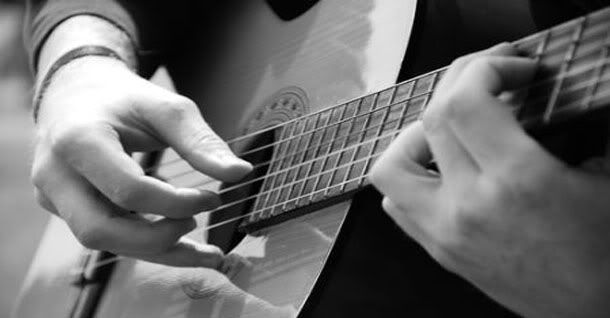
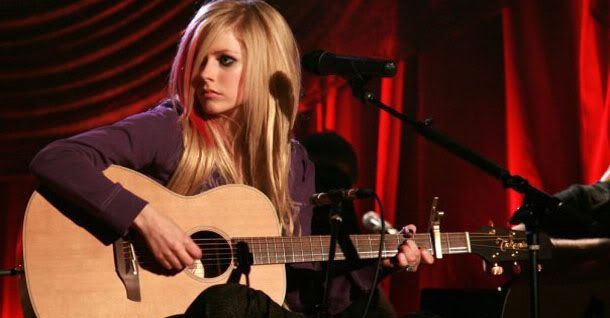

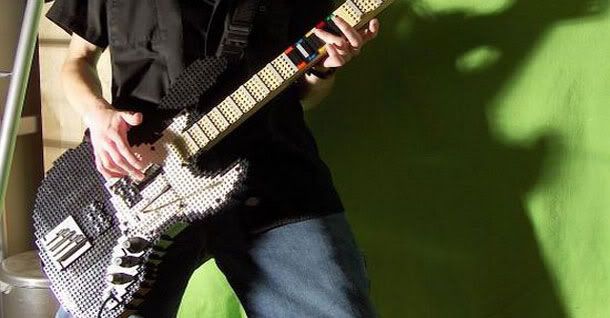
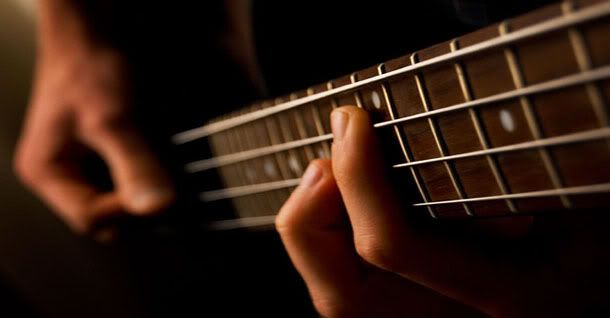
 10:21 PM
10:21 PM
 Basit Ally
Basit Ally


